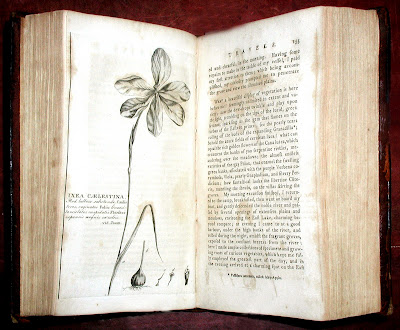William Bartram
William Bartram (1739-1823)
William Bartram
Travels Through North and South Carolina, Georgia, East & West Florida, the Cherokee Country, the Extensive Territories of the Muscogulges, or Creek Confederacy, and the Country of the Chactaws. Containing an Account of the Soil and Natural Productions of those Regions, together with Observations on the Manners of the Indians.
Philadelphia: James and Johnson 1791.
$35,000
There is no naturalist who illustrates American flora and fauna with as much mysticism as William Bartram. In 1739 he was born into a Philadelphia Quaker family who raised him with an ardent devotion to exploring “God’s creation.” With reverent awe, he described the world around him as “a glorious apartment of the boundless palace of the sovereign Creator" and "a glorious display of the Almighty hand[1]." Fed by this spiritual adoration, Bartram’s naturalist career produced unforgettable discoveries and writings that have inspired readers for centuries.
From an early age, William’s father John Bartram cultivated a passion for nature as he himself was the Royal Botanist to King George III. However, William received a higher education than his self-educated father and attended the Philadelphia Academy (a precursor of the University of Pennsylvania), where he studied the classics. Afterwards in 1765, Bartram journeyed to East Florida where he illustrated his father’s notes of the local plant and animal life. At that time Florida was larger, split into east and west territories, and the Treaty of Paris passed ownership from Spain to Great Britain in 1763. During these travels, William developed a keen eye. This resulted in multiple unique observations like his discovery of the “fragile celestial lily” near Lake Dexter, which no other naturalist found for the following 150 years. He also familiarized himself with the bizarre American animals like the gopher tortoise, the sandhill crane, and the Florida alligator, which he described as a dragon-like creature with a “horrifying roar.” Bartram also learned the Native American tribes of Florida, and developed an affinity for their languages and cultures [2].
Later in 1772 Bartram took a commission from John Fothergill to collect specimens from other colonies. Months later he set off on a 2,400 mile voyage through the Carolinas, Georgia, Florida, Alabama, and Louisiana. From this trip he published his classic, Travels Through North & South Carolina, Georgia, East & West Florida, the Cherokee Country, the Extensive Territories of the Muscogulges, or Creek Confederacy, and the Country of the Chactaws; Containing An Account of the Soil and Natural Productions of Those Regions, Together with Observations on the Manners of the Indians. An “invaluable portrait” of 18th century American landscapes, Bartram mixed his classifications of animals and plants with alligator battles, American Indian encounters, and treacherous storm survival[3]. Unlike other early American naturalists, he didn’t just chronicle species. He illustrated the journey of an American spirit in his motherland. Europe adored his work and received it even more eagerly than his local peers. In fact, his book was translated into nearly every major European language. Decades later, America eventually caught on and even John James Audubon accredited the early 19th century Floridian “land boom” to Bartram’s poetic promotion of the state[4].
Besides his tremendous contributions to American natural history, William Bartram left his mark outside of science as well. For botany, he identified 358 southeastern plants and discovered Georgia’s native oak-leaved hydrangea. For art, he produced captivating drawings of plants never seen before. He also inspired British Romantic poets like William Wordsworth, Samuel Taylor Coleridge and American Transcendentalists like Ralph Waldo Emerson and Henry David Thoreau. These men often drew on Bartram’s mystical connection to nature to convey the New World[5]. This reverence for “creation” sets Bartram’s writing and drawings apart, securing his work as a classic for scientists as well as artist historians.
________________________________________
[1] Kirkpatrick, Mary Alice. "William Bartram, 1739-1823 ." Documenting the American South homepage. N.p., n.d. Web. 20 Sept. 2011.
[2] "Florida Naturalists - William Bartram - Introduction." Florida Museum of Natural History. N.p., n.d. Web. 20 Sept. 2011.
[3] Kirkpatrick, Mary Alice. "William Bartram, 1739-1823 ." Documenting the American South homepage. N.p., n.d. Web. 20 Sept. 2011.
[4] "Florida Naturalists - William Bartram - Introduction." Florida Museum of Natural History. N.p., n.d. Web. 20 Sept. 2011.
[5] Kirkpatrick, Mary Alice. "William Bartram, 1739-1823 ." Documenting the American South homepage. N.p., n.d. Web. 20 Sept. 2011.



Comments
Post a Comment